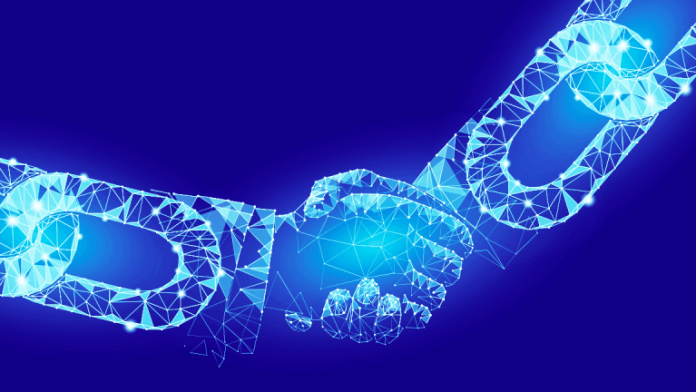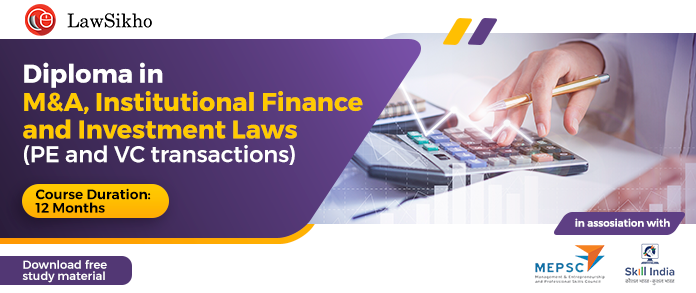This article has been written by Danie Joseph pursuing the Diploma in M&A, Institutional Finance and Investment Laws (PE and VC transactions) from LawSikho.
Table of Contents
Introduction
The year 2021 despite the ongoing pandemic, has seen the resurgence of cryptocurrency and blockchain technology. The potential behind the technology has been inculcated in various facets of business such as finance, supply chain management, insurance, intellectual property security. In India, it is yet to see a regulatory stance on cryptocurrency which is the medium of currency for transactions within the blockchain. Considering the data from various crypto exchanges, there is approximately 15,000 crore worth of cryptocurrencies held within 1.5 crore Indians and the presence of about 300+ startups operating within the blockchain and crypto space which would likely tilt the regulatory implications in favor of the new age technology. Cryptocurrency and blockchain technology have entered their way into the field of mergers and acquisitions as well. Blockchain is seen as the medium to transact in a more secure, transparent, and auditable manner.
This technology is continually being integrated into various aspects. It has evidently been seen in the first merger between two blockchain networks known as Polygon and Hermez. It serves as a precedent for the various transactions and deals that are to be undertaken with the use of the technology. The article seeks to emphasize the various aspects that were considered during the merger between two blockchain networks and also suggestions for implementation of the technology via smart contracts, cryptocurrency to smoothen the process of M&A in the near future.
In August 2021, it observed the first blockchain acquisition of Hermez into the Polygon ecosystem. The article analyses the various intricacies of an M&A deal conducted between blockchains and also looks to highlight the potential of blockchain technology and cryptocurrency in refining the transaction procedure.
The legal implication of the merger
Polygon formerly known as MATIC is an Ethreuem scalability platform. It helps solve some of the challenges faced while conducting transactions in the blockchain such as large amounts of fees, lackluster user experience, and low volume of transactions per second. Polygon owes its origin to four software engineers from India. Polygon has entered new avenues within the blockchain space, such as DApps (Decentralized Applications), DeFi (Decentralised Finance), NFT’s (Non-Fungible Tokens), DAO’s (Decentralized Autonomous Organizations). Polygon’s currency known as Matic has a market capitalization of over $9 billion and is considered as one of the top twenty currencies as per market cap.
Furthermore, Polygon has also gained popularity since the recent investment backing of billionaire investor Mark Cuban. On the other hand, Hermez the other party to the merger is an open-source Zero-Knowledge Rollup (ZK Rollup) that uses mathematical algorithms to verify and settle transactions within the Ethereum platform. Hermez uses the rollups process, which is the industry preferred scaling strategy, and attributing to its decentralized nature it is considered a user favorite. Hermez holds the HEZ token which is its utility currency within its platform.
The Merger
The primary purpose of an M&A is to attain synergy and growth. The business looks out for companies that allow synergy between each other, complement its strengths, and mitigate its weaknesses. Both companies usually look for a win-win situation. Furthermore, M&A serves as a key for a company to enlarge its market share and also venture into new horizons through the attainment of advanced technology and professional personnel.
All the major units of the Hermez scaling technology and the HEZ token will be integrated with Polygon. This would have consisted of transferring all of the IP-related components, if any, and also the skill and intellectual prowess of the employees of Hermez along with the goodwill. It would also be rebranded as Polygon Hermez.
The Polygon network emerged as a platform that enabled the building up of multiple types of applications that were cost-effective, modular, and user friendly. Polygon’s scaling method known as Plasma creates a single transaction per transfer however with ZK Rollups (Zero-Knowledge rollup) allows the processing of multiple transfers into a single transaction. Taking into consideration the zero-knowledge scaling technology Hermez deals in, the intention of Polygon behind the merger can be reasonably assumed.
By acquiring Hermez, it allows access to newer technologies that cannot be obtained otherwise and establishes synergy within all its scaling solutions. By leveraging Hermes’ scaling solution it would procure an advanced form of technology and employ a high standard of security in the transactions which would consequently solidify its position within the Polygon ecosystem and ensure the retention of its users on the platform. With the finalization of the merger, the entity will operate as Polygon Hermez. This will add to the suite of Polygon’s applications such as Polygon PoS, Polygon SDK, Polygon Avail. The collection of various solutions and technical capacity under one umbrella will allow Polygon to tap into various revenue streams to realize its future growth prospects.
The amount of consideration exchanged in pursuance of this transaction was to be reported to amount to 250 million Matic tokens (estimated $250 million) as of 4th August 2021. It also included that Hez token holders would be enabled the facility via a swapping contract to swap the tokens for Polygon’s native token. The ratio for the swap is announced to be 3.5 Matic:1 as per the USD value of both tokens indicated on BitFinex. It has been agreed that Matic will remain as the utility currency in Polygon Hermez.
Future of Blockchains with M&A
The Polygon-Hermez merger sets a precedent as one of the first mergers between two blockchain networks. From a prospective outlook, the technology behind blockchain and cryptocurrency has clear intrinsic potential to streamline the tedious process in conventional M&A. In the Blockchain database, each network user represents a node. Every node validates the transmission of data and as each block is cryptographically connected, it provides maximum security to sensitive information and protects it from hacker attacks. Additionally, the chronological and permanent sequencing of data improves transparency. Therefore blockchain provides value in the form of security and transparency.
- Due diligence – The due diligence process could utilize blockchain technology by providing verified and permanent records of all the data that is disclosed by both parties during the due diligence process. This information serves as a permanent record in the post-merger interaction or in the event of any disputes that arise related to the information disclosed during due diligence.
- Smart Contracts – Smart contracts can be utilized to automate the various processes in M&A. Utilizing smart contracts to automate transactions on the happening of certain events or when obligations are met can increase the level of trust between the parties and reduce incurring any unforeseen or hidden liabilities. Similarly, it could be employed to earn-out payment agreements. Earnouts are mechanisms used in a contract that facilitate payments dependent on a contingent event (e.g. financial benchmark agreed between both parties). Such types of agreements are prominent, evident during the pandemic, attributing to the volatility of the markets and the economy resulting in riskier commercial transactions. Such smart contracts could be designed for instance, where one party to the transaction receives the remainder of the consideration only in the event of a favorable decision regarding a legal suit to which it is a party.
- Crypto-currency – Despite it not being recognized as a legal tender in most countries, there is a large number of high-volume transactions which are undertaken with various cryptocurrencies as a form of consideration. In addition to this, it is an efficient method of transferring huge amounts of value in a matter of seconds without the involvement of any financial institution or intermediary. Coupled with the fact that large amounts of cryptocurrency are being held within retail investors and financial institutions it is a matter of time that deals are undertaken with the use of currency.
This is evident as per reports stating that the value of M&A in the crypto sector doubled by more than $1.1 billion. However, a problem arises due to the gap between when a deal is announced and its closing date as it contains an element of price uncertainty of the currency due to the significant fluctuation in exchanges. This could be solved by establishing a cap and floor price which indicates a bracket within which the value could fluctuate within the agreement between both parties.
- Intellectual Property Rights –
Utilizing the blockchain technology would enable to record data within a distributed ledger in a chronological manner showcasing the date of registrations, licensing of trademark or patent, etc. It would resolve the inconvenience of collecting and storing such evidence physically. An ideal circumstance would be where an original design is uploaded to a blockchain which will entail the creation of a time-stamped record and serves as proof of evidence of conception, qualification requirements, and status. This facility to keep track of the entire life cycle of a right would also smoothen the due diligence processes necessary for IP transactions e.g. Transfer of IP in cases of mergers and acquisitions.
Conclusion
Initially, The Internet came with public uncertainty and criticism and today, it has been integrated into every aspect of our lives, this analogy would serve similar to the technology behind blockchain and cryptocurrency. Despite it being at an unrefined stage, it contains the intrinsic value to be integrated into various aspects including deal-making and transactions. Blockchains technology can enable cross-border payments, trade finance, taxation with various advantages as discussed earlier. It serves as the database to enable higher accuracy and efficiency in terms of time and cost especially for M&A. This technology is considered to be at its infancy and is constantly evolving. It will require the contribution of businesses of various industries to define the design, implementation, and enforcement of the platform and the government to set the regulatory implications. A combined effort will be required in order to harness its potential.
References
- https://www.outlookindia.com/outlookmoney/magazine/story/millions-waiting-to-enter-crypto-space-746
- https://www.coindesk.com/markets/2021/03/29/crypto-mampa-doubled-to-11b-in-2020-pwc/
Students of Lawsikho courses regularly produce writing assignments and work on practical exercises as a part of their coursework and develop themselves in real-life practical skills.
LawSikho has created a telegram group for exchanging legal knowledge, referrals, and various opportunities. You can click on this link and join:
Follow us on Instagram and subscribe to our YouTube channel for more amazing legal content.












